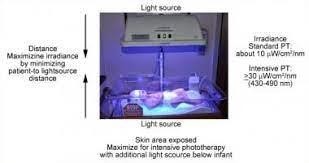A nurse is contributing to the plan of care for a newborn who requires phototherapy for hyperbilirubinemia. Which of the following interventions should the nurse recommend including in the plan?
Apply a water-based ointment to the newborn's skin every 4 to 6 hr.
Give the newborn 30 mL of distilled water after each feeding
Reposition the newborn every 2 to 3 hr.
Monitor the newborn's blood glucose level every 2 hr
The Correct Answer is C
A) Incorrect- Applying ointment to the skin during phototherapy is typically avoided as it can interfere with the effectiveness of the therapy.
B) Incorrect- Giving distilled water after feedings is not a typical intervention for phototherapy.
C) Correct - Repositioning the newborn every 2 to 3 hours is important to ensure adequate exposure of the skin to the phototherapy lights and to prevent pressure points.
D) Incorrect- Monitoring blood glucose levels is not a standard intervention during phototherapy unless there are specific indications for doing so.

Nursing Test Bank
Naxlex Comprehensive Predictor Exams
Related Questions
Correct Answer is C
Explanation
A) Incorrect- While notifying the provider might be necessary, addressing bladder distention takes precedence in this scenario.
B) Incorrect- Administering an analgesic might be indicated for pain relief, but addressing bladder distention is the priority.
C) Correct - Assisting the client to empty her bladder is the first action to take. A full bladder can prevent the uterus from contracting properly and can lead to excessive bleeding.
D) Incorrect- Monitoring perineal pads for clots is important but not the first action to take when bladder distention is present.
Correct Answer is C
Explanation
A) Incorrect- the fundal height corresponds with approximately 16 weeks. At around 16 weeks of gestation, the fundal height is usually located approximately at the midpoint between the symphysis pubis (pubic bone) and the belly button (umbilicus). This measurement corresponds to the anatomical level of the uterus at this stage.
B) Incorrect- the fundal height corresponds with approximately 20 weeks. By 20 weeks of gestation, the fundus has typically reached the level of the umbilicus. The fundal height measurement is around the same level as the belly button.
C) Correct- the fundal height corresponds with approximately 32 weeks. Around 32 weeks of gestation, the fundal height has increased significantly compared to earlier stages of pregnancy. The fundus of the uterus is located above the belly button, and the measurement is typically about 32 centimeters (or roughly 12.6 inches) above the symphysis pubis.
D) Incorrect- the fundal height corresponds with approximately 24 weeks. Around 24 weeks of gestation, the fundal height is usually about 1 to 2 fingerbreadths above the
umbilicus. This represents the ongoing upward growth of the uterus as the pregnancy progresses.
E) Incorrect- the fundal height corresponds with approximately 18 weeks. At around 18 weeks of pregnancy, the fundal height is typically located just above the pubic bone, below the belly button (umbilicus). The fundus of the uterus is still relatively low in the abdomen at this point. The fundal height measurement at 18 weeks is usually around the midpoint between the symphysis pubis (pubic bone) and the belly button.
Whether you are a student looking to ace your exams or a practicing nurse seeking to enhance your expertise , our nursing education contents will empower you with the confidence and competence to make a difference in the lives of patients and become a respected leader in the healthcare field.
Visit Naxlex, invest in your future and unlock endless possibilities with our unparalleled nursing education contents today
Report Wrong Answer on the Current Question
Do you disagree with the answer? If yes, what is your expected answer? Explain.
Kindly be descriptive with the issue you are facing.
